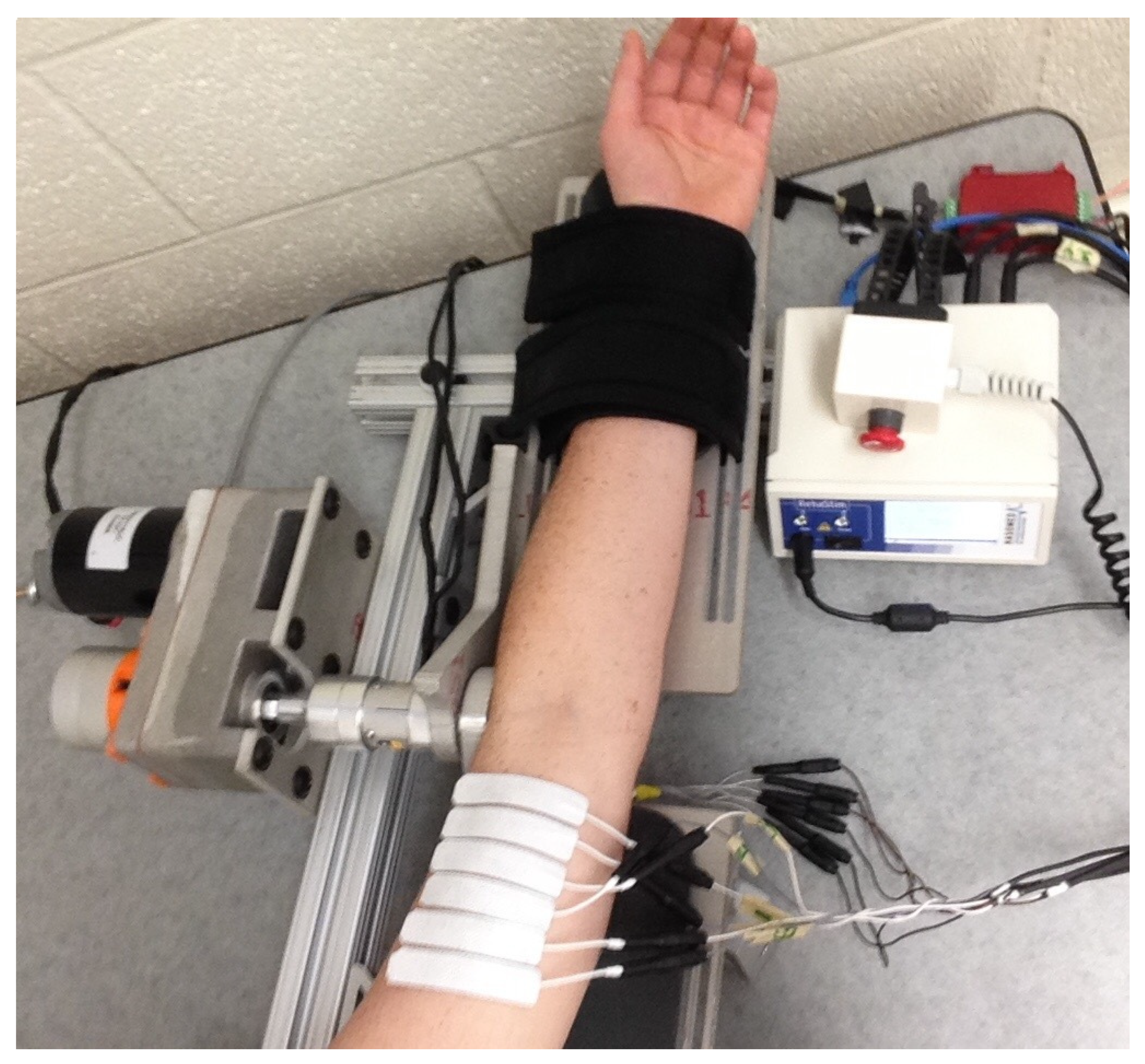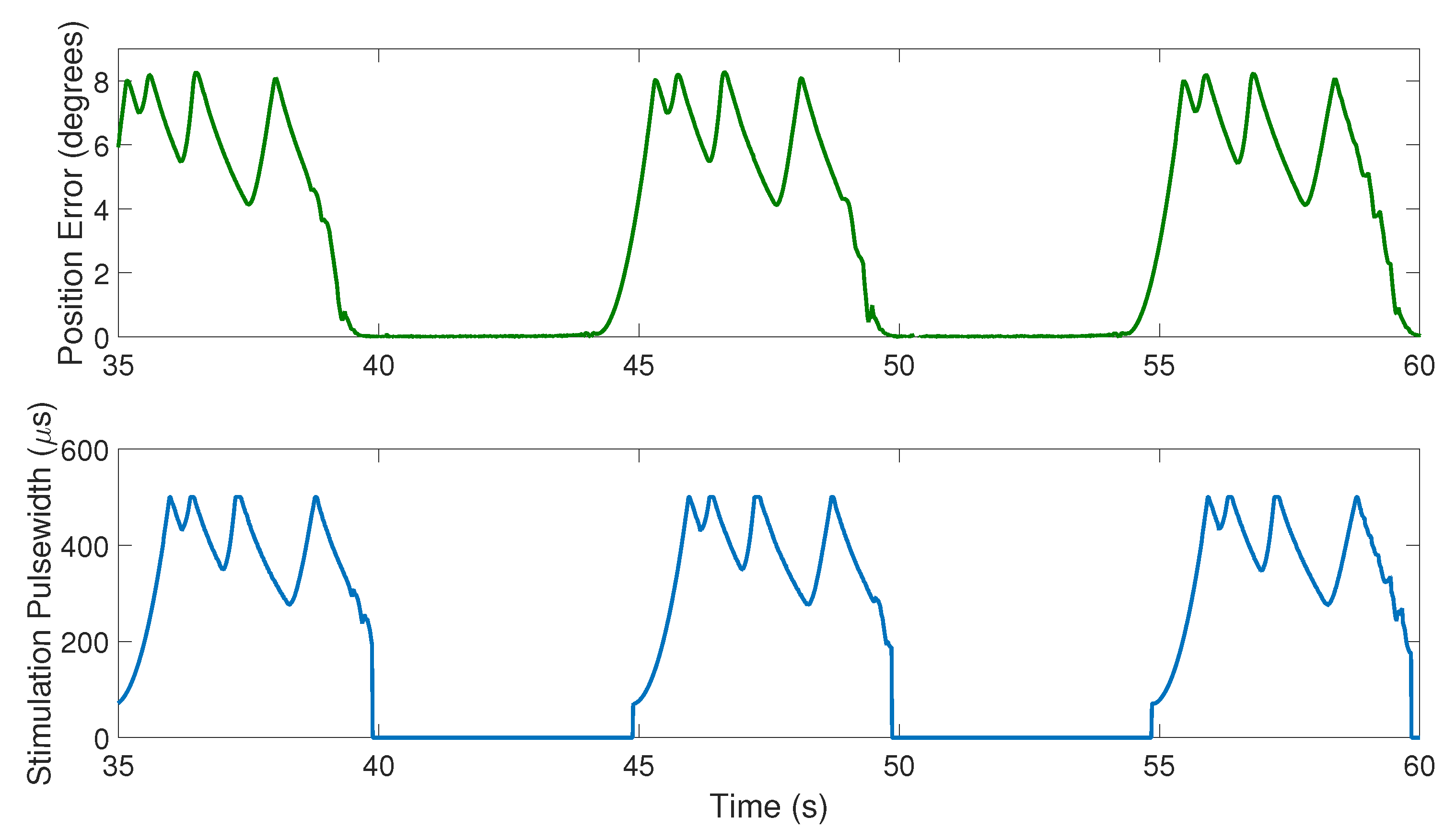Switched Control of Motor Assistance and Functional Electrical Stimulation for Biceps Curls †
Abstract
1. Introduction
2. Materials and Methods
2.1. Dynamics
2.2. Switched Muscle Subsystem
2.3. Control Development
2.4. Stability Analysis
2.5. Experiments
2.5.1. Test Setup
2.5.2. Protocol
3. Results
4. Discussion
5. Conclusions
Author Contributions
Funding
Conflicts of Interest
Abbreviations
| MDPI | Multidisciplinary Digital Publishing Institute |
| DOAJ | Directory of Open Access Journals |
| FES | Functional Electrical Stimulation |
| DC | Direct Current |
| VDC | Voltage Direct Current |
References
- Aisen, M.L.; Krebs, H.I.; Hogan, N.; McDowell, F.; Volpe, B.T. The effect of robot-assisted therapy and rehabilitative training on motor recovery following stroke. Arch. Neurol. 1997, 54, 443–446. [Google Scholar] [CrossRef]
- Masiero, S.; Celia, A.; Rosati, G.; Armani, M. Robotic-Assisted Rehabilitation of the Upper Limb After Acute Stroke. Arch. Phys. Med. Rehabil. 2007, 88, 142–149. [Google Scholar] [CrossRef]
- Riener, R.; Nef, T.; Colombo, G. Robot-aided neurorehabilitation of the upper Extremities. Med. Biol. Eng. Comput. 2005, 43, 2–10. [Google Scholar] [CrossRef]
- Zollo, L.; Gallotta, E.; Guglielmelli, E.; Sterzi, S. Robotic technologies and rehabilitation: New tools for upper-limb therapy and assessment in chronic stroke. Eur. J. Phys. Rehabil. Med. 2011, 47, 223–236. [Google Scholar]
- Poli, P.; Morone, G.; Rosati, G.; Masiero, S. Robotic Technologies and Rehabilitation: New Tools for Stroke Patients Therapy. Biomed. Res. Int. 2013, 2013, 153872. [Google Scholar] [CrossRef]
- Combs, S.; Kelly, S.; Barton, R.; Ivaska, M.; Nowak, K. Effects of an intensive, task-specific rehabilitation program for individuals with chronic stroke: A case series. Disabil. Rehabil. 2010, 32, 669–678. [Google Scholar] [CrossRef]
- Fritz, S.; Merlo-Rains, A.; Rivers, E.; Brandenburg, B.; Sweet, J.; Donley, J.; Mathews, H.; deBode, S.; McClenaghan, B. Feasibility of intensive mobility training to improve gait, balance, and mobility in persons with chronic neurological conditions: A case series. J. Neurol. Phys. Ther. 2011, 35, 141–147. [Google Scholar] [CrossRef]
- Kwakkel, G.; Veerbeek, J.; van Wegen, E.; Wolf, S. Constraint-Induced Movement Therapy after Stroke. Lancet Neurol. 2015, 14, 224–234. [Google Scholar] [CrossRef]
- Krebs, H.I.; Palazzolo, J.J.; Dipietro, L.; Ferraro, M.; Krol, J.; Rannekleiv, K.; Volpe, B.T.; Hogan, N. Rehabilitation robotics: Performance-based progressive robot-assisted therapy. Auton. Robot. 2003, 15, 7–20. [Google Scholar] [CrossRef]
- Cousin, C.; Duenas, V.H.; Rouse, C.; Dixon, W.E. Admittance Trajectory Tracking using a Challenge-Based Rehabilitation Robot with Functional Electrical Stimulation. In Proceedings of the 2018 Annual American Control Conference (ACC), Milwaukee, WI, USA, 27–29 June 2018; pp. 3732–3737. [Google Scholar]
- Frullo, J.; Elinger, J.; Pehlivan, A.U.; Fitle, K.; Nedley, K.; Sergi, F.; O’Malley, M.K. Effects of Assist-As-Needed Upper Extremity Robotic Therapy after Incomplete Spinal Cord Injury: A parallel-Group Controlled Trial. Front. Neurorobot. 2017, 11, 26. [Google Scholar] [CrossRef]
- Pehlivan, A.U.; Sergi, F.; O’Malley, M.K. A Subject-Adaptive Controller for Wrist Robotic Rehabilitation. IEEE Trans. Mechatron. 2015, 20, 1338–1350. [Google Scholar] [CrossRef]
- Chemuturi, R.; Amirabdollahian, F.; Dautenhahn, K. Adaptive training algorithm for robot-assisted upper-arm rehabilitation, applicable to individualised and therapeutic human–robot interaction. J. Neuroeng. Rehabil. 2013, 10, 102. [Google Scholar] [CrossRef]
- Pehlivan, A.U.; Losey, D.P.; O’Malley, M.K. Minimal assist-as-needed controller for upper limb robotic rehabilitation. IEEE Trans. Robot. 2016, 32, 113–124. [Google Scholar] [CrossRef]
- Gomis, M.; Gonzalez, L.; Querol, F.; Gallach, J.; Toca-Herrera, J. Effects of electrical stimulation on muscle trophism in patients with hemophilic arthropathy. Arch. Phys. Med. Rehabil. 2009, 90, 1924–1930. [Google Scholar] [CrossRef]
- Sonde, L.; Gip, C.; Fernaeus, S.; Nilsson, C.; Viitanen, M. Stimulation with low frequency (1.7 Hz) transcutaneous electric nerve stimulation (low-tens) increases motor function of the post-stroke paretic Arm. Scand. J. Rehabil. Med. 1998, 30, 95–99. [Google Scholar] [CrossRef]
- McCabe, J.; Monkiewicz, M.; Holcomb, J.; Pundik, S.; Daly, J.J. Comparison of robotics, functional electrical stimulation, and motor learning methods for treatment of persistent upper extremity dysfunction after stroke: A randomized controlled trial. Arch. Phys. Med. Rehabil. 2015, 96, 981–990. [Google Scholar] [CrossRef]
- Langhammer, B.; Stanghelle, J. Bobath or motor relearning program? A comparison of two different approaches of physiotherapy in stroke rehabilitation: A randomised controlled Study. Clin. Rehabil. 2000, 14, 361–369. [Google Scholar] [CrossRef]
- Rouse, C.; Cousin, C.; Duenas, V.H.; Dixon, W.E. Switched Motorized Assistance during Switched Functional Electrical Stimulation of the Biceps Brachii to Compensate for Fatigue. In Proceedings of the IEEE Conference on Decision and Control, Melbourne, Australia, 12–15 December 2017; pp. 5912–5918. [Google Scholar]
- Rouse, C.; Cousin, C.; Duenas, V.H.; Dixon, W.E. Varying Motor Assistance During Biceps Curls Induced Via Functional Electrical Stimulation. In Proceedings of the ASME Dynamic Systems and Control Conference, Atlanta, Georgia, 30 September–3 October 2018. [Google Scholar]
- Rouse, C.; Duenas, V.H.; Cousin, C.; Parikh, A.; Dixon, W.E. A Switched Systems Approach Based on Changing Muscle Geometry of the Biceps Brachii During Functional Electrical Stimulation. IEEE Control Syst. Lett. 2018, 2, 73–78. [Google Scholar] [CrossRef]
- Gonzalez, E.J.; Downey, R.J.; Rouse, C.A.; Dixon, W.E. Influence of Elbow Flexion and Stimulation Site on Neuromuscular Electrical Stimulation of the Biceps Brachii. IEEE Trans. Neural Syst. Rehabil. Eng. 2018, 26, 904–910. [Google Scholar] [CrossRef]
- Sharma, N.; Stegath, K.; Gregory, C.M.; Dixon, W.E. Nonlinear Neuromuscular Electrical Stimulation Tracking Control of a Human Limb. IEEE Trans. Neural Syst. Rehabil. Eng. 2009, 17, 576–584. [Google Scholar] [CrossRef]
- Schauer, T.; Negård, N.O.; Previdi, F.; Hunt, K.J.; Fraser, M.H.; Ferchland, E.; Raisch, J. Online identification and nonlinear control of the electrically stimulated quadriceps muscle. Control Eng. Pract. 2005, 13, 1207–1219. [Google Scholar] [CrossRef]
- Ferrarin, M.; Pedotti, A. The Relationship Between Electrical Stimulus and Joint Torque: A Dynamic Model. IEEE Trans. Rehabil. Eng. 2000, 8, 342–352. [Google Scholar] [CrossRef]
- Fischer, N.; Kamalapurkar, R.; Dixon, W.E. LaSalle-Yoshizawa Corollaries for Nonsmooth Systems. IEEE Trans. Autom. Control 2013, 58, 2333–2338. [Google Scholar] [CrossRef]
- Paden, B.E.; Sastry, S.S. A calculus for computing Filippov’s differential inclusion with application to the variable structure control of robot manipulators. IEEE Trans. Circ. Syst. 1987, 34, 73–82. [Google Scholar] [CrossRef]
- Liberzon, D. Switching in Systems and Control; Birkhauser: Basel; Switzerland, 2003. [Google Scholar]
- Downey, R.; Merad, M.; Gonzalez, E.; Dixon, W.E. The Time-Varying Nature of Electromechanical Delay and Muscle Control Effectiveness in Response to Stimulation-Induced Fatigue. IEEE Trans. Neural Syst. Rehabil. Eng. 2017, 25, 1397–1408. [Google Scholar] [CrossRef]
- Allen, B.; Cousin, C.; Rouse, C.; Dixon, W.E. Cadence Tracking For Switched FES-Cycling with Unknown Time-Varying Input Delay. In Proceedings of the ASME Dynamic Systems and Control (DSC) Conference, Park City, UT, USA, 8–11 October 2019. [Google Scholar]



| RMS Position Error (deg) | RMS Velocity Error (deg/s) | Average FES Control Input (s) | Average Motor Control Input (Amps) | |
|---|---|---|---|---|
| S1, Impaired/R Arm | 4.26 | 3.70 | 286.7 | 2.08 |
| S1, Unimpaired/L Arm | 3.75 | 4.33 | 317.6 | 1.61 |
| S2, Impaired/R Arm | 4.83 | 5.56 | 354.0 | 1.79 |
| S2, Unimpaired/L Arm | 4.96 | 5.04 | 346.0 | 1.67 |
Publisher’s Note: MDPI stays neutral with regard to jurisdictional claims in published maps and institutional affiliations. |
© 2020 by the authors. Licensee MDPI, Basel, Switzerland. This article is an open access article distributed under the terms and conditions of the Creative Commons Attribution (CC BY) license (http://creativecommons.org/licenses/by/4.0/).
Share and Cite
Rouse, C.; Allen, B.; Dixon, W. Switched Control of Motor Assistance and Functional Electrical Stimulation for Biceps Curls. Appl. Sci. 2020, 10, 8090. https://doi.org/10.3390/app10228090
Rouse C, Allen B, Dixon W. Switched Control of Motor Assistance and Functional Electrical Stimulation for Biceps Curls. Applied Sciences. 2020; 10(22):8090. https://doi.org/10.3390/app10228090
Chicago/Turabian StyleRouse, Courtney, Brendon Allen, and Warren Dixon. 2020. "Switched Control of Motor Assistance and Functional Electrical Stimulation for Biceps Curls" Applied Sciences 10, no. 22: 8090. https://doi.org/10.3390/app10228090
APA StyleRouse, C., Allen, B., & Dixon, W. (2020). Switched Control of Motor Assistance and Functional Electrical Stimulation for Biceps Curls. Applied Sciences, 10(22), 8090. https://doi.org/10.3390/app10228090





